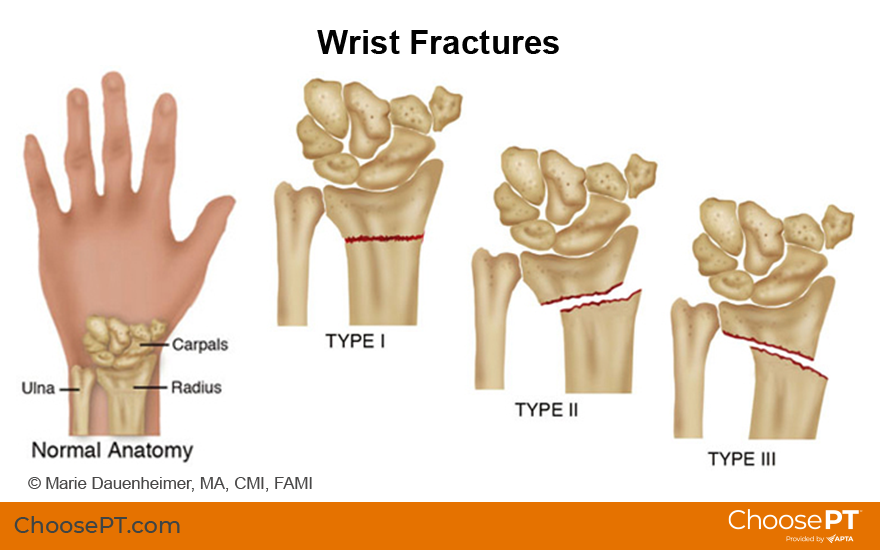Physical Therapy Guide to Wrist Fracture
A wrist fracture is a break in one of the bones near the wrist. In the United States, one in 10 broken bones diagnosed is a wrist fracture. An injury can occur due to trauma, such as falling while playing sports or tripping while walking. Children are susceptible to wrist fractures because of the sports they play or falling off a bike or playground equipment. Wrist fractures are also common in women after menopause and often occur in older adults due to falls.
A physical therapist can help people who have had a wrist fracture regain wrist motion, strength, and function. They also can teach them how to reduce their risk of future fractures.
Physical therapists are movement experts. They improve quality of life through hands-on care, patient education, and prescribed movement. You can contact a physical therapist directly for an evaluation. To find a physical therapist in your area, visit Find a PT.
What Is a Wrist Fracture?
A fracture is a crack or a break in a bone. Wrist fractures due to falls happen most often when people stretch their arms straight out to catch themselves as they fall. The wrist comprises eight small bones called carpal bones and two bones in the forearm called the radius and the ulna. A wrist fracture is diagnosed when any of those bones breaks or cracks. The most frequently fractured bone is the radius, the bone in the forearm closest to the thumb.
There are three types of bone fractures:
- Type 1. The bone is broken but is still in a normal position.
- Type 2. A fragment of bone is shifted from its normal position.
- Type 3. The most serious type of fracture, with multiple breaks of the bone or bones.
Types 1 and 2 fractures usually are treated without surgery. Type 3 fractures typically require surgery.

How Does It Feel?
A fractured wrist is usually painful and affects how your hand, wrist, and arm move. If you have a wrist fracture, you may experience:
- Pain in the fracture area, which could be anywhere in the wrist, depending on which bone was affected. The pain can radiate from the wrist to the fingers and even the forearm.
- Swelling in the wrist and possibly in the hand, usually on the top surface of the wrist and hand.
- Tenderness to touch the wrist.
- Difficulty and pain when moving the wrist or fingers.
How Is It Diagnosed?
An X-ray is the best way to diagnose a wrist fracture. After a fall, if you have any of the symptoms above, go to the emergency room, urgent care, or see your primary care provider to get a diagnostic X-ray. If you see a physical therapist first who suspects a wrist fracture, they may arrange for an X-ray and refer you to a physician.
Your physical therapist can check for damage to other joints and muscles and ensure that the broken bone has not affected the nerves and blood vessels in your wrist, forearm, and hand. Usually, people with fractures see a physician specializing in managing bones and joints (an orthopedist). Depending on the fracture type, the physician might prescribe a cast or a sling to immobilize the area until the fracture is healed. Healing time varies depending on the individual and the fracture type and can take anywhere from four to 10 weeks. If the fracture is severe, you will need surgery. With surgery, the recovery time may be longer, depending on the severity of the injury.
How Can a Physical Therapist Help?
p>Your physical therapist will help you regain normal wrist motion, strength, and function. They also will provide education and training to help you avoid future fractures.
While Your Wrist Is in a Cast or Sling
While your bone heals, your arm will be in a cast or sling to keep it still and promote healing. During that time, it is important to ensure that your arm does not get too stiff, weak, or swollen. Depending on how much activity your physician allows, your physical therapist will prescribe gentle exercises to keep your shoulder, elbow, and fingers moving while your wrist is in the cast or sling.
Most people with wrist fractures return to exercising their other arms and legs so that the rest of their body doesn't get out of shape while their fracture is healing. Your physical therapist can help you adapt your exercise program to maintain your overall strength and fitness without interfering with the healing of your wrist.
When the Cast or Sling Is Removed

After removing your cast or sling, your wrist will most likely be stiff, and your arm will feel weak. Your physical therapist will examine your wrist and select treatments to improve its function and restore strength to your arm.
Your physical therapy plan may include treatments to:
Reduce pain. Your physical therapist might use either warm or cold treatments or gentle electrical stimulation to help control pain or swelling in your wrist, hand, or arm.
Relieve stiffness. Your physical therapist may use skilled hands-on techniques (manual therapy) to enable your joints and muscles to move more freely with less pain.
Increase your strength and ability to move. Physical therapists prescribe several types of exercises during recovery from a wrist fracture. Early on, your physical therapist can help you begin to gently move your elbow using "passive range-of-motion" exercises. As your arm gets stronger, you can exercise it yourself without weights ("active range-of-motion" exercises). Once the bone is healed, you can begin doing resistance exercises using weights or elastic bands. Your physical therapist will prescribe range-of-motion and strengthening exercises when appropriate. They also can help you retrain your muscles to react quickly to help protect yourself from a fall.
Get back to your daily activities. Your physical therapist will help you remain independent by teaching you how to accomplish your daily activities (such as dressing, working on a computer, and cooking), even while wearing a cast or a sling. Once you can move your arm freely without pain, your physical therapist may slowly add activities you did before your injury, such as using your arm to get dressed or do chores. Your physical therapist will design your personalized program based on examining your wrist, your goals, your level of physical activity, and your general health.
Prepare yourself for more demanding activities. Depending on your job requirements or the type of sports you play, you might need additional physical therapy tailored to meet specific demands. Your physical therapist will develop a specialized program to address your unique needs and goals.
Prevent long-term disability.
Everything your physical therapist prescribes for you will help prevent long-term disability. They will assess your fracture and provide guidance and a program to help you:
- Return your arm to a strong level of fitness.
- Safely restore movement and strength while healing occurs.
- Return safely to home and work activities.
- Get back to sports and other physical activities. A return too early after a fracture may increase the risk of another fracture.
- Understand what protective equipment you'll need, such as wrist guards, for use during sports.
Can This Injury or Condition Be Prevented?
In addition to helping individuals prevent long-term disability following a wrist fracture, physical therapists can work with you to help you avoid another fracture in the future.
- For the aging population, avoiding falls and other trauma is the best way to prevent fractures. Physical therapists are experts at determining your risk of falling. They can teach you how to do balance exercises and take precautions to avoid falls. They also can perform work and home safety evaluations to ensure that your environment is safe.
- For postmenopausal women with osteoporosis who have a higher risk of wrist fracture, a physical therapist can teach weight-bearing exercises to help build stronger bones. They also may refer you to a nutritionist for dietary changes to help make your bones stronger. Education in posture and body mechanics and joint protection techniques can help prevent strain on the wrist and arms.
- For children, wearing proper protective gear, such as wrist guards, can reduce the risk of a wrist fracture when playing certain sports. Making sure that your child's playground equipment is safe and built on a soft surface can also reduce the risk of wrist fractures due to falls.
What Kind of Physical Therapist Do I Need?
All physical therapists are prepared through education and clinical experience to treat various conditions and injuries. You may want to consider:
- A physical therapist who is experienced in treating people with orthopedic problems. Some physical therapists have a practice with an orthopedic focus. Some even specialize in the hand, wrist, arm, or shoulder (the upper extremities).
- A physical therapist who is a board-certified clinical specialist or who completed a residency or fellowship in orthopaedic physical therapy. This therapist has advanced knowledge, experience, and skills that may apply to your condition.
You can find physical therapists in your area with these and other credentials through Find a PT, a tool built by the American Physical Therapy Association.
General tips when you're looking for a physical therapist (or any other health care provider):
- Get recommendations from family, friends, or other health care providers.
- Ask about the PT's experience treating wrist injuries before you make an appointment.
- Be prepared to describe your symptoms in as much detail as possible. Make a note of what makes your symptoms worse or better.
The American Physical Therapy Association believes that consumers should have access to information to:
- Inform their health care decisions.
- Prepare them for their visit with a health care provider.
The following resources offer some of the best scientific evidence related to physical therapy treatment of the wrist. They report recent research and provide information on the standards of practice in the United States and worldwide. They link to a PubMed* abstract (which may offer free access to the full text) or to other helpful resources. You can read them to learn more or bring a copy to your health care provider.
Shapiro LM, Kamal RN; Management of Distal Radius Fractures Work Group, et al. Distal radius fracture clinical practice guidelines: updates and clinical implications. J Hand Surg Am. 2021;46(9):807–811. Article Summary in PubMed.
*PubMed is a free online resource developed by the National Center for Biotechnology Information. PubMed contains millions of citations to biomedical literature, including citations in the National Library of Medicine's MEDLINE database.
Expert Review:
Jun 25, 2024
Revised:
Jun 25, 2024
Content Type: Guide
Wrist Fracture
PT, DPT, PhD, board-certified clinical specialist in orthopaedic physical therapy
Chase Kuhn
PT, DPT